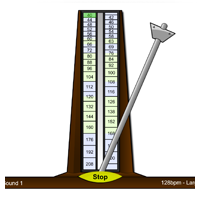

- Online metrognome portable#
- Online metrognome software#
- Online metrognome professional#
- Online metrognome free#
Meter metronome in three - for practicing in 3/4, 3/8, or 9/8 Meter metronome in two - for practicing in 2/4, cut time (2/2), or 6/8 Quadruple subdivision metronome - subdivides the beat into four equal parts, which is useful for practicing sixteenth notes, or eighth notes in cut time. Great for practicing in 6/8, 3/8, or 9/8 time signatures, or for learning triplets. Triple subdivision metronome - subdivides the beat into three equal parts. Great for practicing eighth notes, dotted quarter notes, or any other duple subdivision.

Talking metronome in four - counts "one-two-three-four" in a steady tempo Subdividing Metronomes:ĭuple subdivision metronome - subdivides the beat into two equal parts. Talking metronome in three - counts "one-two-three" in a steady tempo Talking metronome in two - counts "one-two" in a steady tempo Sleigh bell metronome - great for practicing holiday music, it also works well for practicing jazz Talking Metronomes:
Online metrognome portable#
MP3 track metronome - can be used on iPods, iPhones, and other portable devices For an explanation on this process, visit my blog post on MetronomeBot and Flash.īasic metronome - clicks on the beat with a loud wood-block sound The metronomes on this site will continue to work until the year 2020, when Adobe ceases to support Flash. I am currently moving MetronomeBot to my newest site,. This site includes 12 different metronomes to help you practice music better.
Online metrognome free#
Welcome to, the free online talking metronome. Given that there are 60 seconds in a minute, this equates to two beats per second.Home MetronomeBot - The Free Online Metronome that Counts the Beat A tempo of 120 BPM implies that there will be 120 beats sounded in the duration of one minute. Some more advanced metronomes allow for complex time signatures such as 7/8 or 10/8 to be selected and for custom accent patterns to be programmed by the user.īeats per minute or BPM is the unit of measurement commonly used for Tempo. Most metronomes also allow the first beat of each measure to be accented so that you can hear the start of each measure more easily. Waltz time can be achieved by using a time signature of 3/4 (3 beats per measure). Most metronomes will default to a time signature of 4/4 (4 beats per measure) but many other time signatures exist. More advanced metronomes may also allow you to set the time signature at which you want to practice. In this instance, the metronome calculates the BPM from your tapped beats. Tempo is usually set with a tempo control on the metronome but more modern metronomes often provide a tap tempo feature which allows you to tap a few beats at the tempo you desire. A list of tempo markings commonly found in classical music notation can be seen below. Most metronomes default to a setting of 120 BPM which is a common tempo for many styles of music.
Online metrognome software#
Traditionally metronomes were mechanical devices but these days they are more often electronic devices or software applications.Īt the most basic level, the first thing you'll want to do is set the tempo you want to practice at.
Online metrognome professional#
Metronomes are particularly useful for early learners who often struggle with keeping time but even professional musicians use metronomes regularly during practice and performance to maintain constant tempo throughout a piece of music. The audible click then serves as a guide for the musician to stay in time and on the beat. It does this by producing an audible click or pulse at a regular time interval which is usually referred to as tempo and is measured in BPM (beats per minute). A metronome is a device which is used to help musicians keep accurate timing as they practice or perform music.


 0 kommentar(er)
0 kommentar(er)
